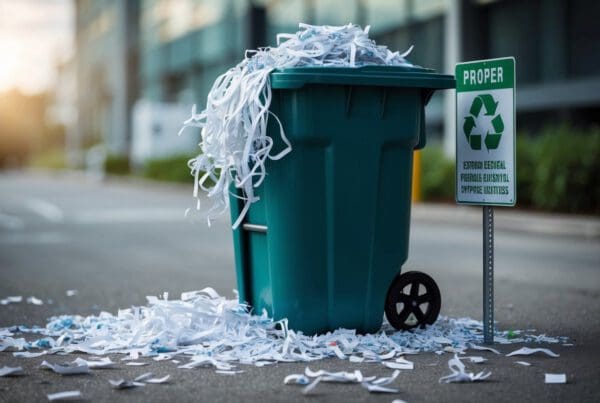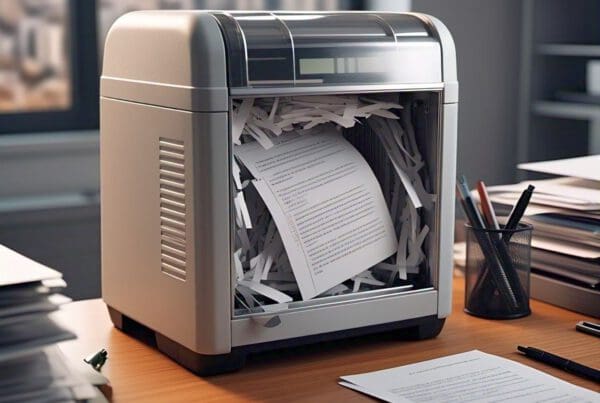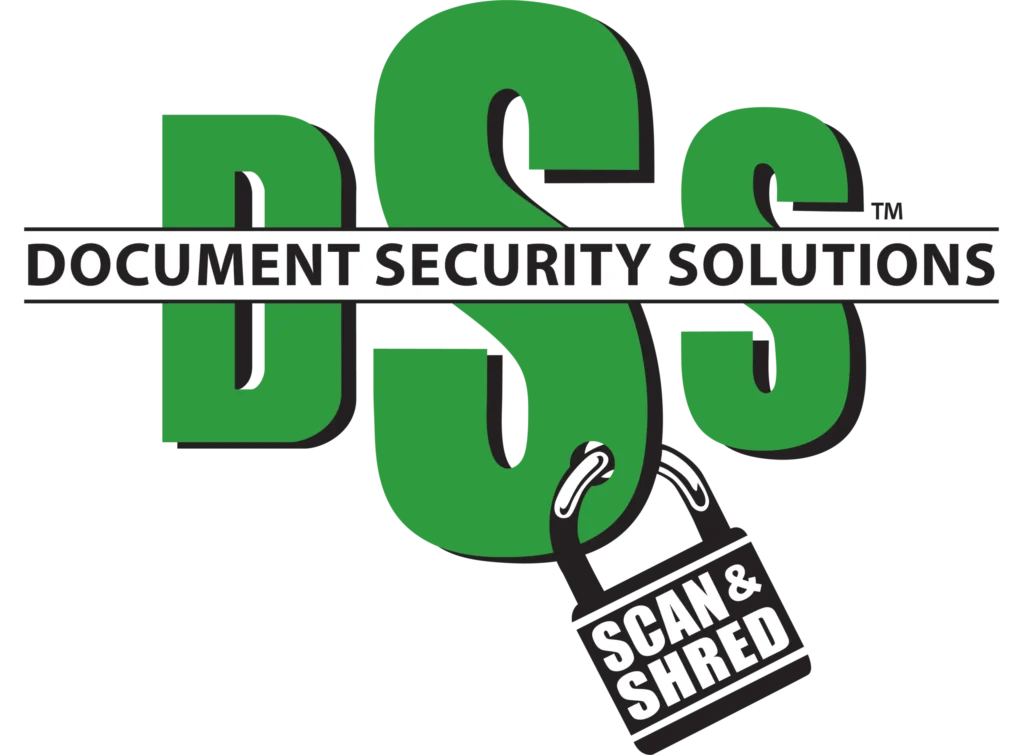The Importance of Sustainable Document Destruction

In a world where sustainability is crucial, responsible document destruction helps protect our environment. It’s important to consider how these practices affect our planet, including the consequences for our ecosystems and carbon emissions.
Environmental Implications of Document Destruction
When documents are not destroyed sustainably, they often end up in landfills, contributing to problems like pollution and deforestation. These actions harm natural habitats and reduce biodiversity, which are essential for healthy ecosystems. Instead, we should focus on processes like recycling and shredding.
Recycling paper from documents can save trees and reduce waste. By using less paper and recycling what we do use, we protect vital resources. Sustainable practices in document destruction also ensure that fewer toxic materials enter our ecosystems. This means less pollution in our soil and water.
Using eco-friendly methods helps maintain our commitment to environmental stewardship. By adopting these practices, we can minimize our environmental impact and ensure a healthier planet for future generations.
Carbon Footprint and Greenhouse Gases
Document destruction methods often involve energy use, which can lead to higher carbon emissions. This contributes to the greenhouse effect, warming our planet and causing climate change. When we use sustainable practices, we reduce our carbon footprint.
Efficient technology and renewable energy can decrease emissions from document destruction. We may choose to use shredders that consume less electricity or are powered by green energy. It’s important to track our carbon emissions and strive to reduce them.
We can minimize our impact by integrating recycling and energy-efficient practices in document disposal. These efforts, though small individually, can collectively contribute to reducing global greenhouse gas emissions. Promoting sustainable practices helps us protect our environment and reduce our carbon footprint.
Sustainable Shredding Practices

We explore methods for making document shredding more eco-friendly. By using energy-efficient equipment and innovative solutions, we strive to reduce our environmental impact while maintaining security.
Eco-Friendly Shredding Solutions
Choosing eco-friendly shredding services is key to sustainable document destruction. These services often recycle shredded paper, reducing waste. By partnering with recycling centers, we ensure that shredded materials are reprocessed into new products.
Using trucks powered by alternative fuels for mobile shredding further minimizes our carbon footprint. Scheduling shredding services during off-peak hours can also save energy. These strategies not only help the environment, but also ensure secure shredding and disposal.
Innovations in Shredding Equipment
Advancements in shredding equipment play a crucial role in sustainable practices. Energy-efficient shredders consume less power, making them cost-effective and environmentally friendly. Modern shredders can handle different materials besides paper, adding versatility to our operations.
Some machines include smart technology that adjusts shredding speed based on material type, reducing energy usage. With regular maintenance, equipment operates at peak efficiency, which prolongs its lifespan and reduces waste. Investing in the latest shredding technology supports our commitment to sustainable shredding practices as we protect sensitive information.
Compliance and Data Security

In document destruction, complying with legal requirements and safeguarding sensitive information are essential. We need to be aware of laws that guide our practices and ensure private data is not compromised during disposal.
Legal Obligations in Document Destruction
Our responsibility in document destruction includes adhering to laws that protect data privacy. The GDPR and HIPAA are examples of regulations requiring us to handle sensitive documents with care. Non-compliance can lead to fines and legal issues.
We must develop practices that align with these laws. This involves clear policies and regular staff training to ensure everyone understands how to manage confidential documents. Utilizing secure disposal methods, such as shredding, helps us meet our obligations and protect data security.
Protecting Sensitive Data During Disposal
Ensuring the protection of sensitive information during disposal requires robust methods. Shredding documents into small, unreadable pieces is an effective way. We should also consider using secure bins for collecting documents slated for disposal to prevent unauthorized access.
Implementing data protection measures involves tracking the handling of sensitive data until it is securely destroyed. We should document each step taken to ensure compliance and accountability. By prioritizing these practices, we uphold information security standards and safeguard our organization’s data.
Waste Management and Recycling Processes
Effective waste management and recycling practices help reduce landfill waste and promote sustainability. By recycling materials like shredded paper, we contribute to a circular economy and embrace environmental responsibility.
Reducing Landfill Waste through Recycling
Recycling reduces the amount of waste that ends up in landfills. Paper waste is a significant part of landfill waste, and recycling paper can greatly cut this down. By recycling shredded paper, we keep unnecessary waste out of landfills.
Recycling facilities play a key role in this process. They sort, clean, and repurpose discarded paper to create recycled materials. This not only reduces landfill waste but also conserves resources and energy. Proper waste management with recycling helps us make sustainable choices every day.
Integrating Circular Economy Principles
The circular economy focuses on designing out waste and keeping materials in use. We incorporate these principles by ensuring that paper waste is reused, remanufactured, or recycled. This approach minimizes the need for new raw materials.
Our recycling practices aim to support a closed-loop system. By doing this, we promote waste reduction and environmental responsibility. When we recycle materials, they get a second life, turning what was once considered waste into valuable resources.
Together, through thoughtful waste management, we can enhance our commitment to sustainability.
Environmental and Business Benefits
Sustainable practices in document destruction help us reduce costs and conserve resources. These efforts align with corporate sustainability goals, benefiting both the environment and our business.
Cost Efficiency of Sustainable Practices
Opting for sustainable methods in document destruction can lead to noticeable cost savings. By enhancing energy efficiency, we lower power consumption during the shredding process. Using machines that are more efficient reduces our energy bills. Additionally, sustainable practices often involve recycling shredded materials. This recycling not only reduces waste disposal costs but can also generate revenue by selling recyclable materials.
Choosing the right equipment also matters. High-efficiency shredders require less electricity, supporting our energy conservation efforts. Plus, integrating water-saving techniques in the process ensures further savings. These strategies collectively help our organization reduce expenses, making sustainability a smart business choice.
Achieving Sustainability Goals
Incorporating sustainable practices in document destruction aligns with our sustainability initiatives. By focusing on environmental conservation, we help reduce our carbon footprint. This approach enhances our contributions to corporate sustainability. It’s crucial for us to support sustainability goals by minimizing waste and pollution.
Our efforts in environmental conservation extend to energy and water management. Reducing energy consumption and improving energy efficiency are key steps we take to achieve our goals. Similarly, we emphasize water conservation, ensuring that our practices don’t unnecessarily deplete resources. As businesses prioritize environmental sustainability, adopting such practices establishes us as responsible and forward-thinking leaders.





